Yves Parlier: Always The Innovator
Published on December 15th, 2015
Frenchman Yves Parlier, now 55 years, helped set a standard in offshore sailing that his countrymen have dutifully followed. Elected France’s top sports personality in 2002, he remains the innovator…
The only souvenir Yves Parlier has kept from his long career sailing the seven seas is the skeleton of a mahi-mahi, or common dolphinfish, almost one metre long. In February 2001, somewhere near the island of Saint Helena in the South Atlantic, he caught this fish with a hook made from a broken aerial. It saved him from dying of hunger.
Even now Parlier licks his lips at the thought of the feast that followed. “I started by devouring the offal, then I stripped the fillets and put them out to dry,” he says. “After that I sucked the bones and ate the skin. I had enough food to reach the finish.”
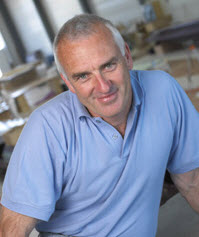 Parlier made this miraculous catch while he was competing in his third and final Vendée Globe single-handed around-the-world race, sailed non-stop and without assistance, a contest he never managed to win. Dispirited and desperately hungry, he had spent the previous 10 days mixing packets of dehydrated food with platefuls of seaweed and krill, seasoned with the spices from oriental soup packets.
Parlier made this miraculous catch while he was competing in his third and final Vendée Globe single-handed around-the-world race, sailed non-stop and without assistance, a contest he never managed to win. Dispirited and desperately hungry, he had spent the previous 10 days mixing packets of dehydrated food with platefuls of seaweed and krill, seasoned with the spices from oriental soup packets.
Damage to the vessel had forced him to stop for several days, dipping so far into his reserves he was no longer sure he could make it to the finish at Sables d’Olonne in western France.
“It was a nightmare,” he explains. “The weather was foul, my onboard phone had broken down and the inside of the boat, slippery with seaweed, really stank. I was so famished I wolfed my cheese and chocolate rations for a whole fortnight in just two days. I was only three or four days away from Brazil, and I was very tempted to throw in the towel and head for the coast.”
A few weeks earlier, when he was one of the leaders in the race, alongside Michel Desjoyeaux and Roland Jourdain, the mast of Aquitaine-Innovations, his 18-metre yacht, broke into three pieces. It was only 12 metres high, instead of 27. He refused to call for assistance, which would have disqualified him. So he moored in an inlet on Stewart Island, just off the coast of New Zealand. Here he managed to patch things up well enough to get home.
“I suppose I was the perfect candidate for this operation, because I started out with an engineering degree specialising in composite materials,” Parlier says with a grin. He borrowed five 25W bulbs from his navigation lights, slipped an electric wire inside the stump of the mast and made a “furnace” by layering a fleece jacket, survival blanket and sleeping bag.
He thus succeeded in extending his mast by six metres, a job that usually requires a crane. “I managed to bring the temperature up to 60C, enough to polymerise the bonding agents required for the repairs,” he adds, as if this was child’s play.
The international media took a keen interest in the work of this contemporary equivalent of Robinson Crusoe, commissioning a French photographer on a nearby trawler to get pictures of the makeshift repairs. They revealed Parlier, sporting long hair and a beard, trussed up in a survival suit and clinging to a raft made of tanks and crates, paddling back and forth between the shore and his battered craft.
Born in Versailles, Parlier moved to the Bordeaux area of southwest France to complete his training. He has always seen the sea as a sort of laboratory. In 1985 he was the first person to fit a racing yacht with a carbon-fibre mast, a real-life application for his degree dissertation. By the mid-1990s he was happier using rapeseed biofuel for his power generator rather than diesel. He even gave up carrying a desalination system, preferring to take a few jerrycans of drinking water and collect rainwater.
In 2001 he convinced the Aquitaine regional council, his longstanding sponsor, to back his project to build a twin-masted catamaran with stepped hulls, in the hope of setting new records. Unfortunately this scheme was shelved in 2006 for lack of funds. “We had doubled the record for the number of nautical miles travelled in 24 hours and there was still loads of potential, but there are times when it’s better not to be too far ahead of the curve,” he jokes.
But Parlier still feels a visceral need to contribute to innovation in sailing. In 2014 he launched Beyond the Sea to develop ways of using very large kites for marine propulsion. The aim, of course, is to save energy. In his workshop, located in the technology park at Teste de Buch, on the coast near Bordeaux, the retired skipper produces a little bag and pulls out a huge light-blue sail.
“The interesting thing about a kite is that it doesn’t produce any drag. When not in use it can be packed away, taking up no deck space,” he asserts. The kite is fitted with position and motion sensors, and can be adjusted using three hydraulic hoists controlled by a computer.
According to Parlier, widespread use of such systems would cut fuel consumption on trading ships by 20% straight away, with a corresponding effect on greenhouse gas emissions. “Bearing in mind that 90% of global trade travels by sea and that there are 100,000 cargo ships and about 1 million fishing boats, this technology could have a major, positive impact on the environment,” he adds.
His project, which involves universities, engineering schools, laboratories and industry, is still at the research and development stage. “We are keen to join forces with demonstrators and shipping companies interested in testing and improving the system,” Parlier says. For a craft about 20 metres long the system costs about €100,000 ($110,000), all told.
The captain of a Quebec-based shrimping vessel, who is already using one of the kits, received help from the province’s Energy Efficiency Agency. Parlier tested another one on a 15-metre racing trimaran belonging to Lalou Roucayrol, a local skipper. When the vessel capsized during the 2013 edition of the Jacques Vabre transatlantic race, the two sailors brought it home from Madeira using just three kites.
“We’re still a bit out on a limb,” Parlier admits. SkySails opened the way in Germany, fitting a 160 sq metre sail to a 132 metre cargo vessel in 2008, but they put the project on standby and switched to generating electricity using kites. “Over the past 18 months the price of oil has plummeted, the excuse cited by the Germans for not pursuing the matter,” he adds. “But shipping companies must still be interested because increasingly strict standards require them to use cleaner, more expensive fuel.”
Source: Guardian Weekly
Editor’s note: Yves’s son Nicolas is among the innovators and elite competitors on the international Formula KiteFoil circuit. As Nicolas shared in this Scuttlebutt report, he is working with his dad to push that sport even further.


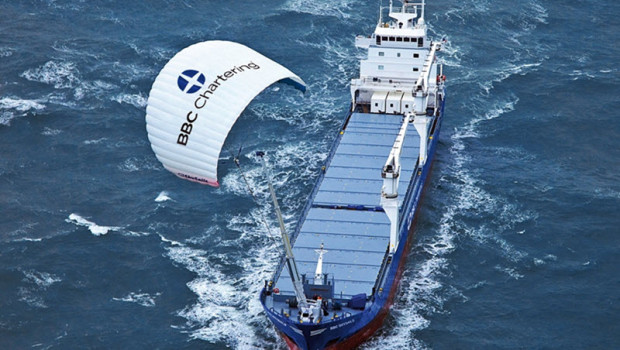


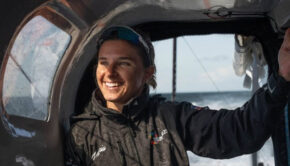
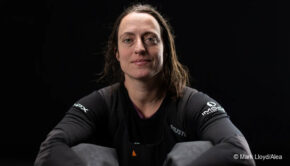
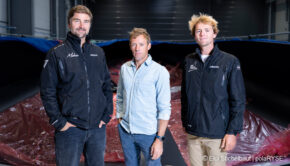
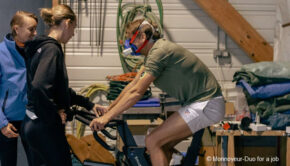
 We’ll keep your information safe.
We’ll keep your information safe.